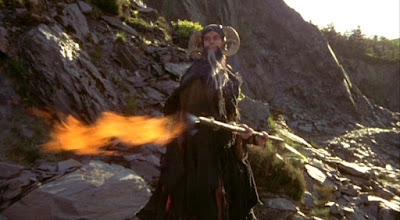I'm sure that most of us have heard of this film. "Monty Python and the Holy Grail" re-imagines the classic tale of King Arthur of Camelot from a comedic standpoint. Along with his Knights of the Round Table, Arthur is sent by God in a quest for the "holy grail". Through each peril suffered by the group as individuals and as a whole, Arthur and Sir Bedevere (the only knight left by the end) finally reach the Castle of Aaargh where the "holy grail" is said to be found. Unfortunately for them, their efforts turn out to be fruitless, for the two "brave men" find that the castle has been seized by the same Frenchmen who taunted them earlier on in the film.
The very first day of class, the first question that was asked was "What do you think of when you hear the word 'medieval'?" Of course, many of the obvious things were listed: knights, quests, kingdoms/castles, dragons, religion (monks), and so on and so forth. By adding comedy into the mix, Monty Python exhibits a not only wonderful but utterly hilarious example of what it was like to live in Medieval times and what we typically consider to be "medieval", without leaving out a single detail. As far as what knowledge one might take from this film about the time period, in accordance with Monty Python's depiction, it appears as though everyone was either "a knight", "a witch or sorcerer", "had plague", or "was on a quest" of some kind.
Thus, the film begins with our "brave knights": King Arthur, Sir Lancelot, Sir Robin, Sir Bedevere, and Sir Galahad . Here, one takes notice that Arthur and his gang are donned in the common outfits for knights of the time: chainmail, armor, shields and the like:
As the movie progresses, the knights each encounter a different set of circumstances. A few examples include Arthur's battle with the Black Knight. This is one of few scenes that I find to be a bit of a cliché. You have Arthur battling your stereotypical "dark knight", who refuses to allow he and his "horse" to pass through. Not as original, but hilarious nonetheless:
Arthur and Bevedere's "battle" with the Knights who say "Ni!" Rather than simply allow them to pass, the knights request a sacrifice, which is just a shrubbery:
As well as Sir Robin's "stop" with the Three-headed Knight. In this scene, it is possible that the group may have been a bit critical towards the knightly position. Instead of sticking around to fight the knight, Sir Robin "turns his tail and flees":
In addition to their quest, the film makes several references to differing aspects of the time, such as the class system. In this version, the peasants apparently handle their kingdom "constitutionally" rather than follow a king:
Plus any diseases being spread around, such as the Plague. From this point, the group takes a satirical route, by presenting the disposal of dead bodies as being similar to our system of trash disposal:
As well as references to any "magic" that may have been practiced at the time, by those believed to be witches/sorcerers, as this scene shows here. Not to mention, we have the iconic Tim the Sorcerer below:
By taking several of these elements, mashing them together and adding their own comedic twists and turns, it appears that the better question is not what makes "Monty Python and the Holy Grail" medieval, but rather what doesn't make it so. While the film appears to be critical of the time period at certain points, I find that the film is meant to be complementary, by taking some of its various aspects and qualities that otherwise would sound a bit horrible and making them slightly more enjoyable. Additionally, I find that the clever twists and satiric nature provide insight into the simple fact that while medieval life may not have always been great, that didn't mean that it was unenjoyable. Thus, while Arthur did not walk away with his "grail", it seems that he still had boatloads of fun on his quest.
As a bonus, here's one of my
favorite scenes. Hope you enjoy!




This was really informative and I love the use of pictures and videos used to get your point across. I also liked the personal feelings with the use of your favorite scene. You made excellent points on the medieval themes. Well done!!
ReplyDeleteI also analyzed Monty Python and the Holy Grail! I loved the way you added so many pictures and videos, it really added depth to your post. Also, I really connected with the statement "what doesn't make Monty Python Medieval" because there were so many different aspects that I had to choose from too and I bet you felt the same struggle. Overall, this was a great post!
ReplyDelete